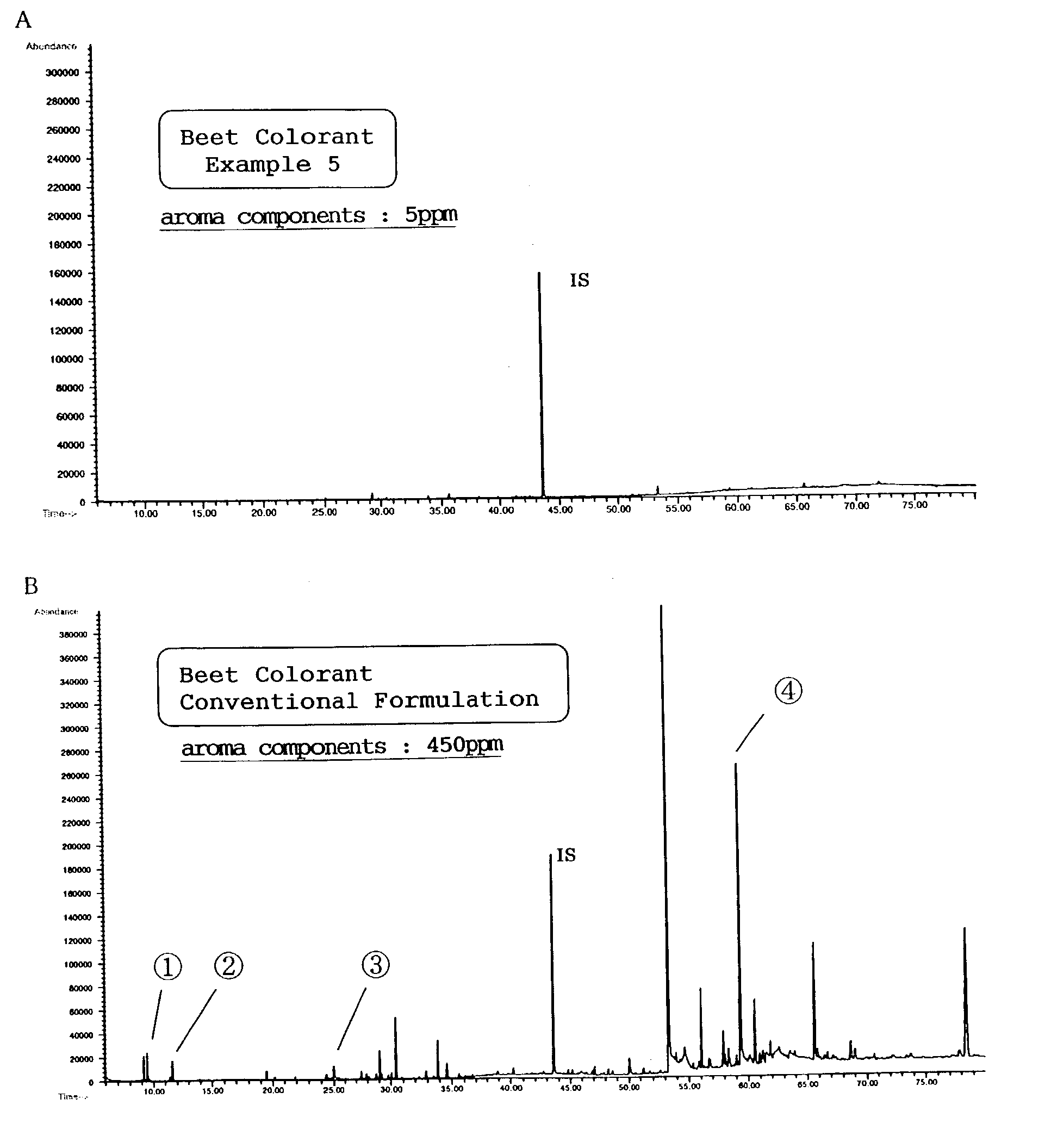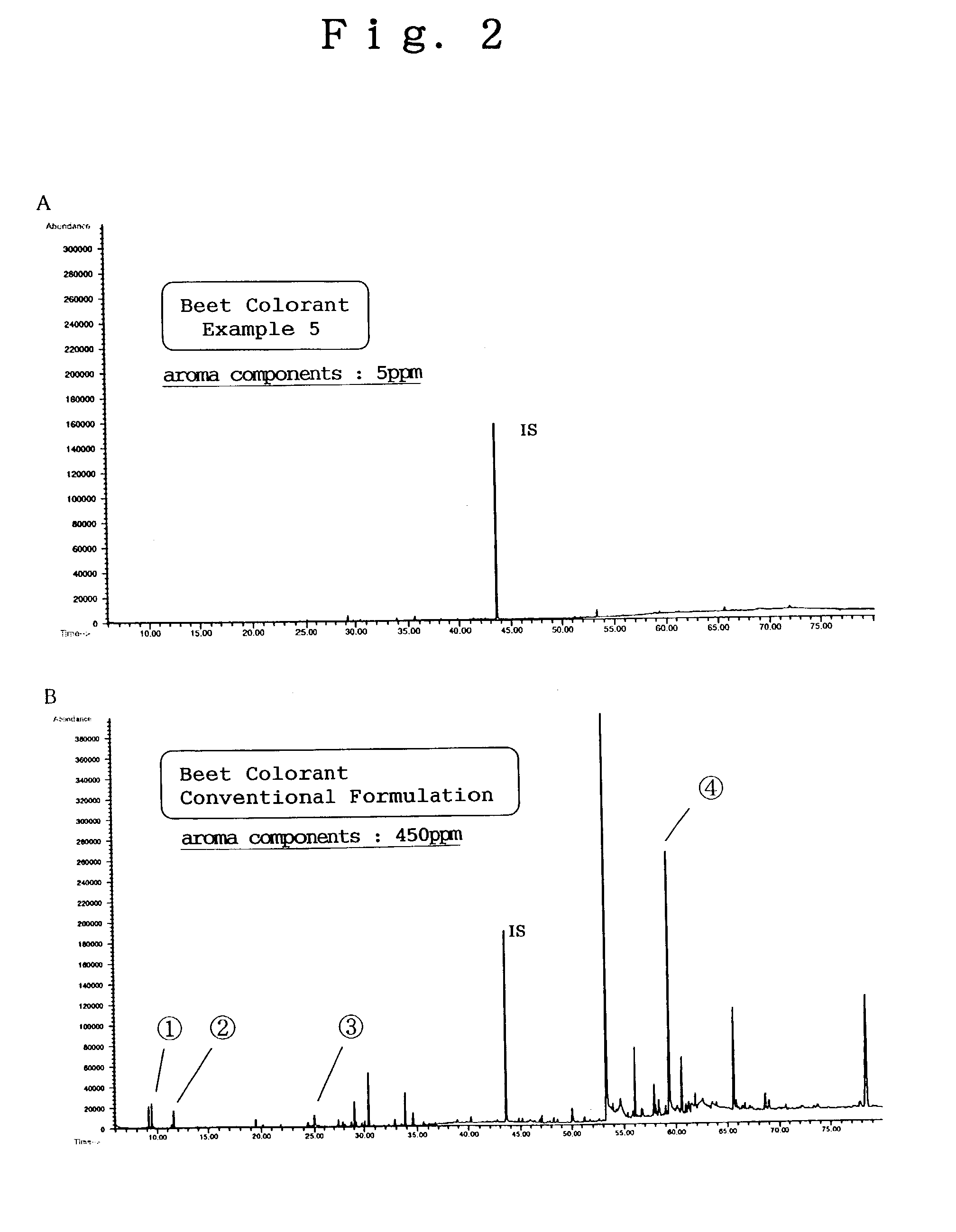Deodorized colorant of brassicaceae plant
a technology of brassicaceae and colorant, which is applied in the field of deodorization colorant of brassicaceae plant, can solve the problems of odor that can sometimes undetectedly taint the flavor, taste and aroma of these products, can not be considered satisfactory colorant formulation, and odor that gradually becomes stronger, and achieves the effect of little adverse
- Summary
- Abstract
- Description
- Claims
- Application Information
AI Technical Summary
Benefits of technology
Problems solved by technology
Method used
Image
Examples
example 1
Brassicaceae Plant (Red Cabbage) Colorant Formulation (Solution)
[0095]4.8 L of a primary-purified colorant extract (adsorption-treated Brassicaceae plant colorant extract) obtained by the same method as in Comparative Example 1 was treated at 20° C. and 3.5 kg / cm2 with an ultrafiltration membrane (AHP-2013 Membrane, trademark of Asahi Chemical; molecular weight cut off: 50,000) (membrane separation treatment). The treated extract thus obtained was then adjusted to a pH of 2.0 with sulfuric acid, the product of which was stirred for 30 minutes at a temperature of 40 to 80° C. (acid treatment). 5 L of water was then added to this acid-treated extract to perform a reverse osmosis membrane treatment (NTR-7250 Membrane, trademark of Nitto Denko, molecular weight cut off: about 3000), which gave 1 L of membrane-treated extract (membrane separation treatment). The aroma component and impurities in the red cabbage were removed as filtrate here, and the purified and deodorized colorant compo...
example 2
Brassicaceae Plant (Red Cabbage) Colorant Formulation (Solid)
[0096]60 g of water and 15 g of dextrin were added to 32 g of a colorant extract that had been significantly deodorized and purified and had a color value E10%1 cm of 200, which had been prepared by the same method as in Example 1. This product was spray-dried to prepare 25 g of a red cabbage colorant powder formulation whose color value E10%1 cm was 250. This colorant was odorless.
example 3
GC-MS Measurement
[0097]The amounts of aroma components contained in the red cabbage colorant formulation manufactured in Comparative Example 1 (comparative product) and the red cabbage colorant formulation manufactured in Example 1 (present invention product) were compared with a gas chromatography-mass spectrometer (GC-MS). Specifically, 10 g of each colorant (color value E10%1 cm=80) was extracted with 200 mL of diethyl ether containing 3 ppm an internal standard substance (IS: 2,6-di-tert-butyl-4-methylphenol (BHT)). This diethyl ether solution was then dried by evaporation, and the concentrate thus obtained was put in a gas chromatography-mass spectrometer (GC-MS) to measure the amount of aroma component.
[0098]
GC-MS measurement conditionsGC / MSHewlett-Packard 5973 Mass Selective DetectorColumnDB-WAX made by J&W (0.25 mm × 60 m)Temperatureinlet 250° C., interface 230° C.column temperature 50° C. (2 min.) −220° C.,elevation rate 3° C. / min.Split ratio70:1Ionization electrode70 eV
[00...
PUM
 Login to View More
Login to View More Abstract
Description
Claims
Application Information
 Login to View More
Login to View More - R&D
- Intellectual Property
- Life Sciences
- Materials
- Tech Scout
- Unparalleled Data Quality
- Higher Quality Content
- 60% Fewer Hallucinations
Browse by: Latest US Patents, China's latest patents, Technical Efficacy Thesaurus, Application Domain, Technology Topic, Popular Technical Reports.
© 2025 PatSnap. All rights reserved.Legal|Privacy policy|Modern Slavery Act Transparency Statement|Sitemap|About US| Contact US: help@patsnap.com



